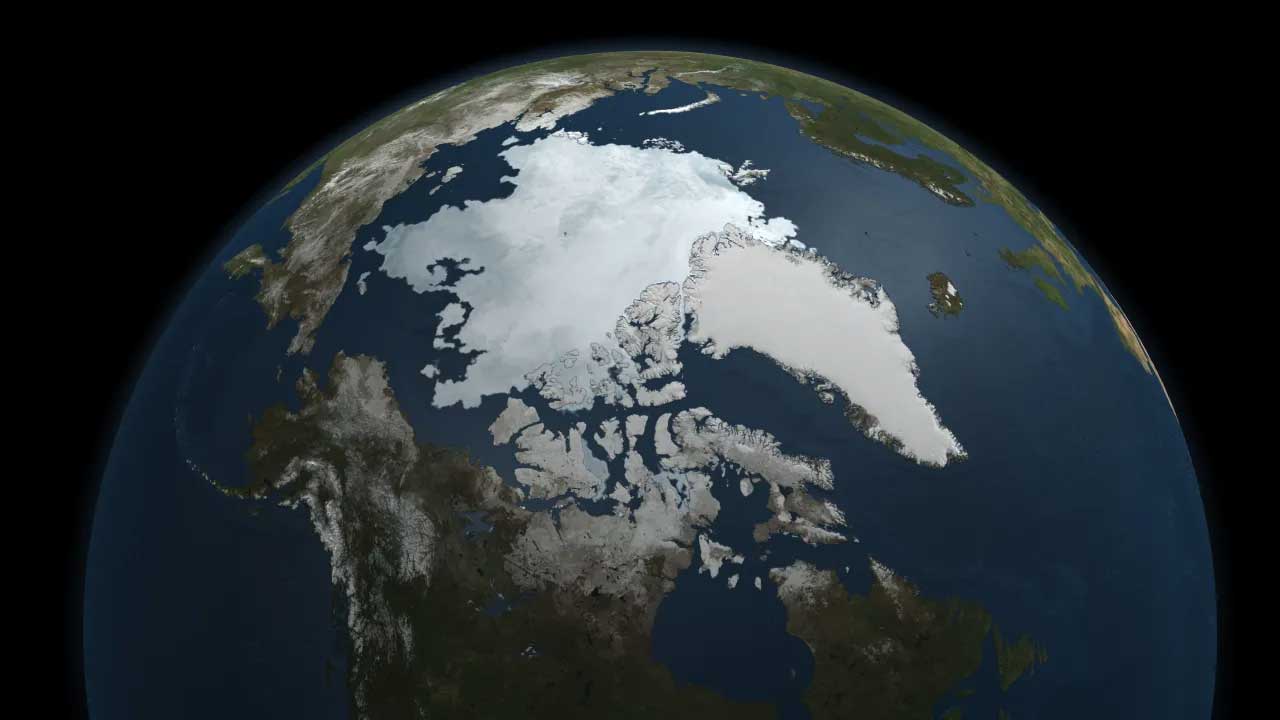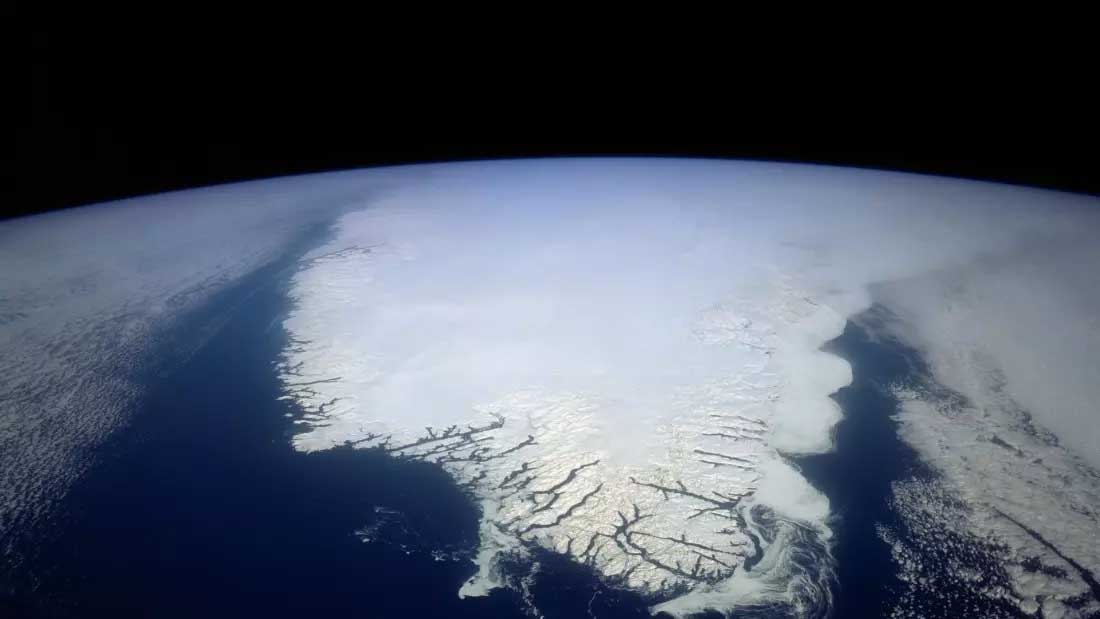Researchers used more than 120 years of data to understand how melting ice, depleting groundwater and rising sea levels are shifting the planet’s rotation axis and lengthening the days.
Days on Earth are getting slightly longer, and the change is accelerating. The reason is related to the same mechanisms that have also caused the planet’s axis to shift about 30 feet (10 meters) over the past 120 years. The findings come from two recent NASA-funded studies that focused on how climate-related redistribution of ice and water has affected Earth’s rotation.
This redistribution occurs when ice sheets and glaciers melt more than they grow from snowfall, and when aquifers lose more groundwater than they replenish from precipitation. These resulting mass shifts cause the planet to wobble as it rotates, and its axis to shift, a phenomenon called polar motion. They also cause the Earth’s rotation to slow, as measured by the lengthening of the day. Both of these phenomena have been recorded since 1900.
By analyzing the polar motion over 12 decades, scientists attributed nearly all of the periodic oscillations to changes in groundwater, ice sheets, glaciers, and sea levels. According to a paper recently published in Nature Geoscience, the mass changes over the 20th century were largely the result of natural climate cycles.
The same researchers teamed up for a follow-up study that focused on day length. They found that since 2000, days have been getting longer by about 1.33 milliseconds per 100 years, faster than at any time in the previous century. The reason: the accelerated melting of glaciers and ice sheets in Antarctica and Greenland due to human-caused greenhouse gas emissions. Their findings were published July 15 in the Proceedings of the National Academy of Sciences.

The Arctic is captured in this 2010 visualization using data from NASA’s Aqua satellite. New research quantifies how climate processes, including the melting of ice sheets and glaciers, drive the movement of the poles. Another study looks at how polar meltwater accelerates the lengthening of Earth’s days. NASA Science Visualization Studio
“The overall message from these two papers is that climate changes at the Earth’s surface, whether human-induced or not, are powerful drivers of the changes we see in the planet’s rotation,” said Surendra Adhikari, a co-author of both papers and a geophysicist at NASA’s Jet Propulsion Laboratory in Southern California.
In the early days, scientists tracked the polar motions by measuring the apparent motion of stars. Later, they switched to very-long-baseline interferometry, which analyzes radio signals from quasars, or satellite laser ranging, which points lasers at satellites.
Researchers have long suspected that the polar movements are the result of a combination of processes inside and on the Earth’s surface. Less clear is how much each process moves the axis and what effect each has — cyclical movements that repeat over periods of weeks to decades, or steady drifts over centuries or millennia.
For their paper, the researchers used machine learning algorithms to analyze the 120-year record. They found that 90% of the recurring fluctuations between 1900 and 2018 could be explained by changes in groundwater, ice sheets, glaciers, and sea levels. The rest was mostly the result of Earth’s internal dynamics, such as wobbles due to the tilt of the inner core relative to the main body of the planet.
The patterns of polar motion associated with shifts in surface masses have repeated several times about every 25 years during the 20th century, leading researchers to believe that they were largely driven by natural climate change. Previous work has linked the more recent polar motion to human activity, including Adhikari’s, which attributed the sudden eastward shift (beginning around 2000) to faster melting of the Greenland and Antarctic ice sheets and depletion of groundwater in Eurasia.
The study focused on the past two decades, during which groundwater and ice mass loss and sea level rise (all measured by satellites) were closely linked to human-induced climate change.

Scientists have found that melting ice in Greenland and the polar regions is causing sea levels to rise, shifting mass around the planet in a way that causes its rotation to slow. NASA
“It is true to some extent” that human activity influences the motion of the poles, said Mostafa Kiani Shahvandi, lead author of both papers and a doctoral student at Switzerland’s ETH Zurich University. “But there are natural modes in the climate system that have a major influence on the oscillations in the motion of the poles.”
The position of the Earth’s rotation axis has shifted by about 30 feet (10 meters) between 1900 and 2023, as shown in this animation. A recent study found that about 90% of the periodic oscillations in the polar motion can be explained by melting ice sheets and glaciers, decreasing groundwater, and rising sea levels.
For the second paper, the authors used satellite observations of mass change from the Gravity Recovery and Climate Experiment (GRACE) mission and its sequel GRACE-FO, as well as previous mass balance studies that analyzed the impact of changes in groundwater, ice sheets, and glaciers on sea level rise in the 20th century, to reconstruct changes in day length caused by these factors from 1900 to 2018.
Scientists know from historical records of eclipses that the length of the day has been increasing over the millennia. Although this is almost imperceptible to humans, the delay must be taken into account because many modern technologies, including GPS, rely on precise timekeeping.
In recent decades, faster melting of ice sheets has shifted mass from the poles toward the equatorial ocean. This alignment is causing the Earth to slow down and the days to lengthen.
The authors noticed a spike in the rate of day lengthening just after 2000, a change that closely correlated with independent equalization observations. Between 2000 and 2018, the rate of day lengthening due to ice and groundwater movement was 1.33 milliseconds per century — faster than any time in the previous 100 years, when it ranged from 0.3 to 1.0 milliseconds per century.
The researchers note that the extension, caused by changes in ice and groundwater, could slow by 2100 under a climate scenario with significant emissions reductions. (Even if emissions stopped today, previously emitted gases, especially carbon dioxide, would persist for decades.)
If emissions continue to rise, the lengthening of days due to climate change could reach 2.62 milliseconds per century, outpacing the lunar tide pull, which has been increasing Earth’s day length by an average of 2.4 milliseconds per century. This effect, called lunar tidal friction, has been the main reason for the lengthening of Earth’s days for billions of years.
NASA’s newest climate mission has begun collecting data on the amount of heat, in the form of far-infrared radiation, that the Arctic and Antarctic environments emit into space. These measurements, Polar Radiant Energy in the Far-Infrared Experiment (PREFIRE), are key to better predicting how climate change will affect Earth’s ice, seas, and weather — information that will help humanity better prepare for a changing world.
One of PREFIRE’s two shoebox-sized cube satellites, or CubeSats, launched May 25 from New Zealand, and its twin launched June 5. The first CubeSat began sending back science data July 1. The second CubeSat began collecting science data July 25, and the mission will release the data once a problem with the CubeSat’s GPS system is fixed.
The PREFIRE mission will help researchers gain a clearer picture of when and where the Arctic and Antarctica emit far-infrared radiation (wavelengths longer than 15 micrometers) into space. This includes how atmospheric water vapor and clouds affect the amount of heat that escapes from Earth. Because clouds and water vapor can trap far-infrared radiation near Earth’s surface, they can increase global temperatures in a process known as the greenhouse effect. This is when gases in Earth’s atmosphere — such as carbon dioxide, methane, and water vapor — act as insulators, preventing the heat emitted by the planet from escaping into space.
“We are constantly looking for new ways to observe the planet and fill critical gaps in our knowledge. With CubeSats like PREFIRE, we are doing both,” said Karen St. Germain, director of the Earth Science Division at NASA Headquarters in Washington. “The mission, part of our competitively selected Earth Venture program, is a great example of the innovative science we can achieve through collaboration with universities and industry partners.”
Earth absorbs most of the sun’s energy in the tropics; weather and ocean currents transport that heat to the Arctic and Antarctic, which receive much less sunlight. Polar environments—including ice, snow, and clouds—radiate a lot of that heat into space, much of it in the form of far-infrared radiation. But these emissions have never been systematically measured, which is where PREFIRE comes in.
“It’s so exciting to see the data coming in,” said Tristan L’Ecuyer, PREFIRE’s principal investigator and a climate scientist at the University of Wisconsin-Madison. “With the addition of far-infrared measurements from PREFIRE, we’re seeing for the first time the full spectrum of energy that Earth is radiating into space, which is critical to understanding climate change.”
This visualization of PREFIRE data shows brightness temperatures — or the intensity of radiation emitted by Earth at multiple wavelengths, including far infrared. Yellow and red colors indicate more intense emissions coming from Earth’s surface, while blue and green represent lower emission intensities, coinciding with cooler regions on the surface or in the atmosphere.
The visualization begins by showing mid-infrared radiation data (wavelengths between 4 and 15 micrometers) collected in early July during several polar orbits of the first CubeSat to be launched. It then zooms in on two flybys of Greenland. The orbital tracks are expanded vertically to show how far-infrared radiation changes in the atmosphere. The visualization ends by focusing on the area where the two passes intersect, showing how far-infrared intensity changed over the nine hours between the two orbits.
The two PREFIRE CubeSats are in asynchronous, near-polar orbits, meaning they pass over the same points in the Arctic and Antarctic within hours of each other, collecting the same data. This gives researchers a time series of measurements they can use to study relatively short-lived phenomena, such as ice sheet melting or cloud formation, and how they affect far-infrared radiation over time.
The PREFIRE mission was jointly developed by NASA and the University of Wisconsin-Madison. NASA’s Jet Propulsion Laboratory, a division of Caltech in Pasadena, California, manages the mission for NASA’s Science Mission Directorate and provided the spectrometers. Blue Canyon Technologies built and operates the CubeSats, and the University of Wisconsin-Madison processes and analyzes the data collected by the instruments.




